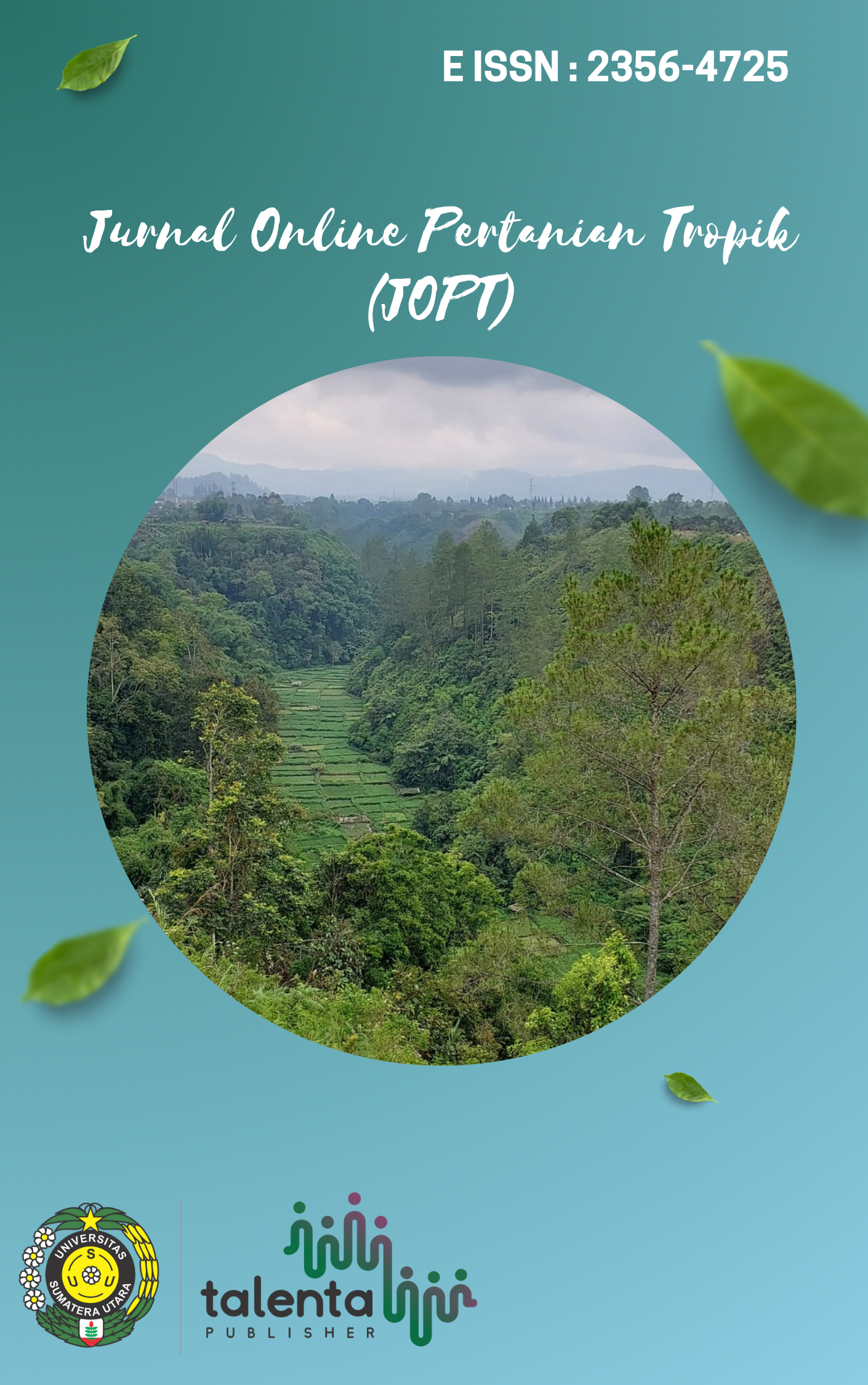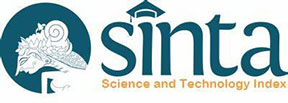Quality Characteristics of Clove Leaf Essential Oil Based on Leaf Pretreatment Using the Steam Distillation Method
DOI:
https://doi.org/10.32734/jpt.v12i1.17252Keywords:
Clove leaves, Essential oils, Distillation, qualityAbstract
Cloves are a plant that is often used as an ingredient in cooking or as an addition to cakes. The clove plant is not only used for its cloves, but its leaves can also produce great benefits. Some of the benefits of clove leaves include that they can be used for various types of treatment, including cough medicine, stomach ache medicine, and toothache medicine. The quite diverse chemical content in clove leaves provides quite open opportunities for use, one of which is being used as a raw material for producing essential oils. The aim of this research is to determine the suitability of the quality of the essential oil obtained in the form of yield, specific gravity, refractive index and solubility in 90% alcohol in accordance with the Indonesian National Standard (SNI) produced from clove leaves using the steam distillation method. The research method used in this research is an experimental method by conducting experiments in the laboratory. The treatments used were whole clove leaves (S1), clove leaves chopped at 50% (S2) and 25% (S3) of the total length of clove leaves, and crushed clove leaves (S4). The parameters of this research are yield, specific gravity, refractive index, and solubility in 90% alcohol. The results of the research showed that the best treatment was obtained from clove leaf samples chopped at 25% of the total leaf length which had the highest average yield and specific gravity, namely 2.88% and 1.061 g/ml. The refractive index value and the average solubility of clove leaf essential oil in each sample treatment met the Indonesian national standard (SNI 06-2387-2006).
Downloads
References
Feriyanto, Y. E., Sipahutar, P. J., Mahfud, M., & Prihatini, P. (2013). Pengambilan minyak atsiri dari daun dan batang serai wangi (Cymbopogon winterianus) menggunakan metode distilasi uap dan air dengan pemanasan microwave. Sepuluh Nopember Institute of Technology.
Hernawati, N. S., Budiarti, A., & Mahfud, M. (2012). Proses pengambilan minyak atsiri dari daun nilam dengan pemanfaatan gelombang mikro (microwave). Sepuluh Nopember Institute of Technology.
Holili, M. (2021). Pengaruh Kuat Gradien Tegangan Dan Lama Waktu Terhadap Rendemen Dan Sifat Fisik Minyak Atsiri Dari Rimpang Kunyit Putih (Curcuma Zedoaria Rosc.) Dengan Ohmic Assisted Hydrodistillation (Oahd)(Doctoral Dissertation, Universitas Brawijaya). Universitas Brawijaya.
Khasanah, L. U., Kawiji, K., Utami, R., & Aji, Y. M. (2015). Pengaruh perlakuan pendahuluan terhadap karakteristik mutu minyak atsiri daun jeruk purut (Citrus hystrix DC). Jurnal Aplikasi Teknologi Pangan, 4(2).
Koensoemardiyah, S. (2010). A to Z Minyak Atsiri untuk Industri Makanan, Kosmetik dan Aromaterapi. Yogyakarta: CV Andi Offset.
Kurniawan, A., Rahayu, W. S., & Wahyuningrum, R. (2016). Perbandingan kadar eugenol minyak atsiri daun cengkeh (Syzygium Aromaticum (L) Merr & Perry) yang tumbuh di dataran tinggi dan dataran rendah. Pharmacy: Jurnal Farmasi Indonesia (Pharmaceutical Journal of Indonesia), 6(03).
Meyla Aryawati, F., & Nyuwito, N. (2017). PENGARUH PERLAKUAN BAHAN DAN MASSA DAUN CENGKEH TERHADAP RENDEMEN DAN KUALITAS MINYAK DENGAN METODE AIR DAN UAP.
Nugraheni, K. S. (2012). Pengaruh Perlakuan Pendahuluan dan Metode Destilasi Terhadap Karakteristik Mutu Minyak Atsiri Daun Kayu Manis (Cinnamomum Leaf Oil burmannii).
Nurdjannah, N. (2004). Diversifikasi penggunaan cengkeh. Perspektif: Review Penelitian Tanaman Industri, 3(2), 61–70.
Perdana, L. R., Lutfi, M., & Hendrawan, Y. (2015). Uji Performansi Unit Penyulingan Uap Daun Cengkeh Skala Laboratorium dengan Pretreatment Pencacahan Daun. Journal of Tropical Agricultural Engineering and Biosystems-Jurnal Keteknikan Pertanian Tropis Dan Biosistem, 3(3), 295–302.
Porawati, H., & Kurniawan, A. (2019). Rancang Bangun Alat Penyuling Minyak Atsiri Tumbuhan Nilam Metode Distilasi Air dan Uap. Jurnal Inovator, 2(1), 20–23.
Rusli, M. S. (2010). Sukses memproduksi minyak atsiri. AgroMedia.
Sasongko, P., Washington, W., & Ahmadi, K. G. S. (2022). Potensi Usaha Pengolahan Minyak Atsiri Daun Cengkeh Di Kecamatan Sipora Selatan Kabupaten Kepulauan Mentawai. Journal of Food Technology and Agroindustry, 4(2), 100–115.
Sastrohamidjojo, H. (2004). Kimia Minyak atsiri [Book].-Yogyakarta. Gajah Mada University Press.
Sebayang, E. P. P. (2011). Pengendalian Mutu Minyak Atsiri Sereh Wangi (Citronella Oil) di Ukm Sari Murni Dusun Pabongan Rt 01 Rw 05, Desa Berjo, Kec. Ngargoyoso Kab. Karanganyar.
Syarifah, T. (2017). Ekstraksi Minyak Atsiri Dari Batang, Daun dan Kulit Jeruk Purut (Citrus hystrix DC) Dengan Metode Solvent-Free Microwave Extraction. Tesis. Institut Teknologi Sepuluh Nopember. Surabaya.
Utomo, D. B. G., & Mujiburohman, M. (2018). Pengaruh kondisi daun dan waktu penyulingan terhadap rendemen minyak kayu putih. Universitas Muhammadiyah Surakarta.
Yuliarto, F. T. (2012). Pengaruh ukuran bahan dan metode destilasi (destilasi air dan destilasi uap-air) terhadap kualitas minyak atsiri kulit kayu manis (Cinnamomum burmannii).
Zainurin, N. A. A., Hashim, Y., Azmin, N. F. M., & Abbas, P. (2018). Agarwood Leaf essential oil characterization and effects on MCF-7 breast cancer cells. International Journal on Advanced Science, Engineering and Information Technology, 8(4–2), 1604–1609.
Zaituni, Z., Khathir, R., & Agustina, R. (2016). Penyulingan minyak atsiri sereh dapur (Cymbopogon citratus) dengan metode penyulingan air-uap. Jurnal Ilmiah Mahasiswa Pertanian, 1(1), 1009–1016.
Downloads
Published
How to Cite
Issue
Section
License
Copyright (c) 2025 Jurnal Online Pertanian Tropik

This work is licensed under a Creative Commons Attribution-ShareAlike 4.0 International License.






















